US Dollar Exchange Rates of
25th
Aug
2024
China Yuan 7.12
Report from China
Real estate investment down over 10%
China’s National Bureau of Statistics has, in a press
release, reported that in the period January to July 2024,
investment in real estate development decreased year on
year by 10% and investment in residential buildings was
down by 11%.
In the same period the floor space of real estate under
construction was down by 12% year on year and for
residential buildings it was down around 13%.
The floor space of newly started buildings was down by
23%, of which floor space of newly started residential
buildings was down by 24%. The floor space of completed
buildings was down by 22% of which the floor space of
residential buildings was also down by 22%.
See:
https://www.stats.gov.cn/english/PressRelease/202408/t2024082
2_1956035.html
Slight decline in total sawnwood imports
According to China Customs data, in the first half of 2024
China’s sawnwood imports totalled 13.96 million cu.m,
worth US$3.588 billion, down 2% both in volume and in
value. CIF prices for sawnwood imports rose 0.5% slightly
to US$257/cu.m compared to the same period of 2023.
Of total sawnwood imports, sawn softwood imports fell
6% to 8.87 million cu.m, accounting for 64% of the
national total, down 2 percentage points over the same
period of 2023. The CIF prices for sawn softwood imports
rose 0.8% to US$205/cu.m over the same period of 2023.
Sawn hardwood imports grew 5% to 5.09 million cu.m.
CIF prices for sawn hardwood imports dropped 3% to
US$348/cu.m over the same period of 2023.
Of total sawn hardwood imports, tropical sawnwood
imports were 3.69 million cu.m valued at US$1.077
billion, up 16% in volume and 18% in value and
accounting for about 26% of the national total. CIF prices
for tropical sawnwood grew 2% to US$292/cu.m over the
same period of 2023.
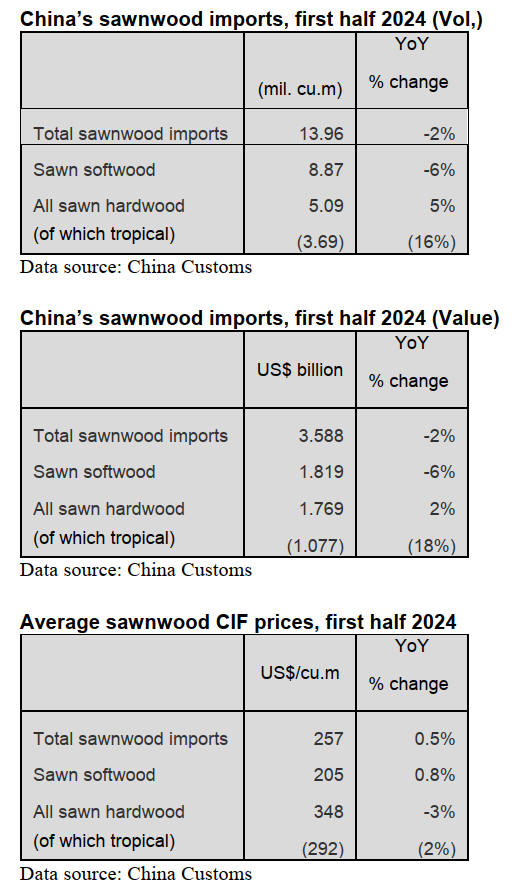
The main reasons for the decrease in China’s sawnwood
imports mainly resulted from the slump in construction
industry which has weakened China's overall demand for
imported timber.
A seasonal slowdown caused by the rainy season in
southern China also contributed to slower overall timber
demand. China’s sawnwood imports from its lead
suppliers, reduced generally in the first half of 2024,
especially from the largest, Russia.
Imports from Russia down 4%
Russia remains the largest supplier of sawnwood to China
and imports in the first half of 2024 accounted for 65% of
the total. However, Russian imports fell 4% to 6.242
million cu.m and contributed to the downturn in China’s
overall total sawnwood imports.
At the same time, China’s sawnwood imports from the
main supply countries also decreased and at a faster pace,
in the first half. Imports from Canada, USA, Finland,
Germany, Philippines and Sweden dropped 8%, 18%,
27%, 31%, 15% and 44% respectively over the same
period compared to 2023. In contrast, China’s sawnwood
imports from Thailand, Belarus and Gabon rose 21%, 44%
and 58% respectively.
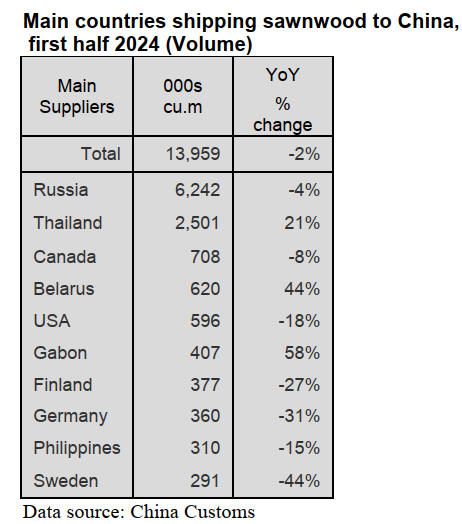 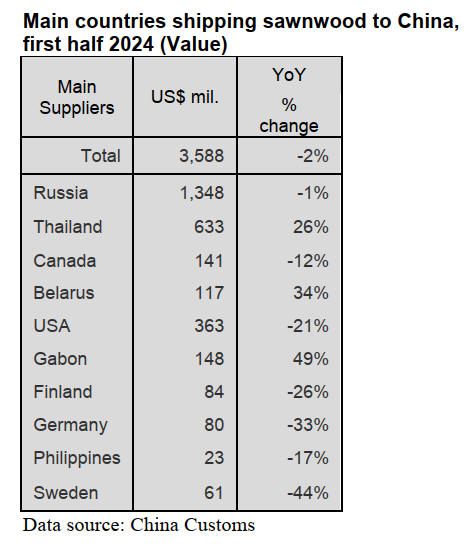
Jump in sawn softwood imports from US
In the first half of 2024, China’s sawn softwood imports
from the USA rose 38% to 111,000 cu.m, accounting for
1.3% of the national total sawnwood imports. This did not,
have much affect on the overall trend of decline in the
total sawn softwood imports in the first half of 2024.
In the first six months China’s total sawnwood imports
from USA totaled 596,000 cu.m, down 18% over the same
period in 2023. This decrease in the overall sawnwood
total is because of the decline in China’s sawn hardwood
imports from USA. 80% of China’s sawnwood imports
from USA are of sawn hardwood and these fell 25% to
484,000 cu.m in the first half of 2024.
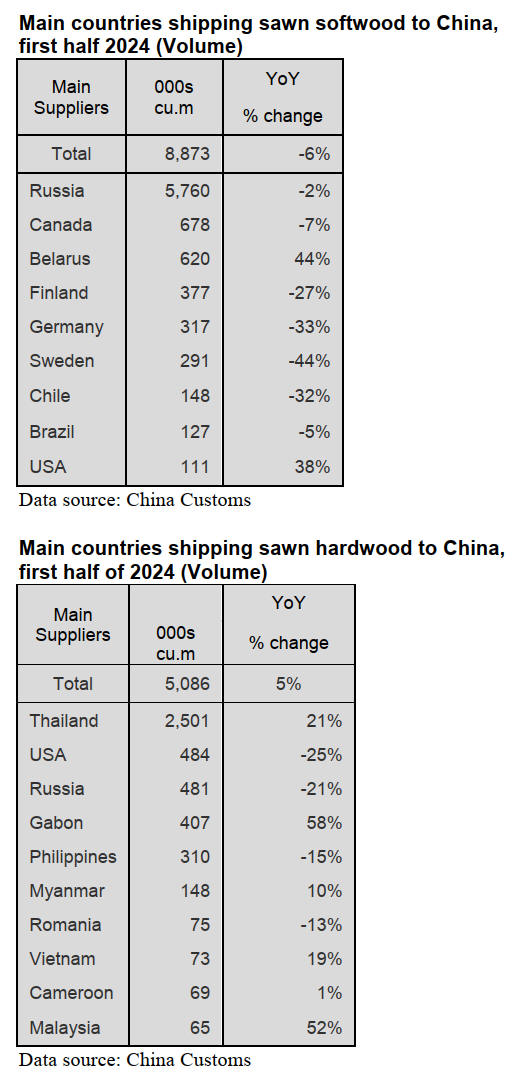 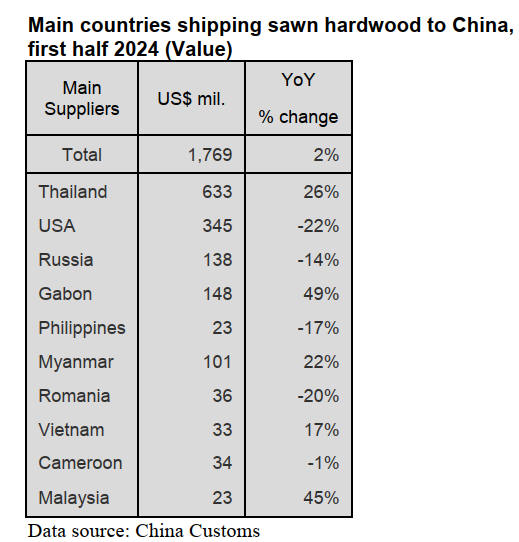
Tropical sawnwood imports rise
China’s tropical sawnwood imports in the first half of
2024 reached 3.69 million cu.m, worth US$1.077 million,
an increase of 16% in volume and 18% in value on the
same period of 2023. They accounted for about 26% of its
national sawnwood import total for the six months. CIF
prices for tropical sawnwood grew 2% to US$292 per
cu.m compared to 2023.
Thailand has been China’s largest tropical sawnwood
supplier for many years. In the first half of 2024 its
shipments to China rose 20% in volume over the same
period in 2023 to 2.49 million cu.m and 25% in value to
US$631 million. They accounted for 68% of China’s total
tropical sawnwood imports, an increase in share of 4%
over 2023. The CIF price for China’s tropical sawnwood
imports from Thailand was US$253 per cu.m, up 4%.
Surge in tropical sawnwood imports from Gabon
Gabon’s tropical sawnwood exports to China rose sharply
in the first half of 2024, making it the country’s second
largest supplier, ahead of the Philippines in third place.
The two countries accounted for for 11% and 8% of
China’s total tropical sawnwood imports respectively in
the period. Imports from Gabon were up 59% to 402,000
cu.m and the Philippines’ 15% to 308,000 cu.m.
China’s top 10 countries tropical sawnwood suppliers
provided 97% of its total first half imports, namely
Thailand (68%), Gabon (11%), Philippines (8%),
Myanmar (4%), Cameroon (1.9%), Malaysia (1.7%),
Indonesia (1.1%), the Republic of Congo (0.8%), Laos
(0.55%) and PNG (0.51%).
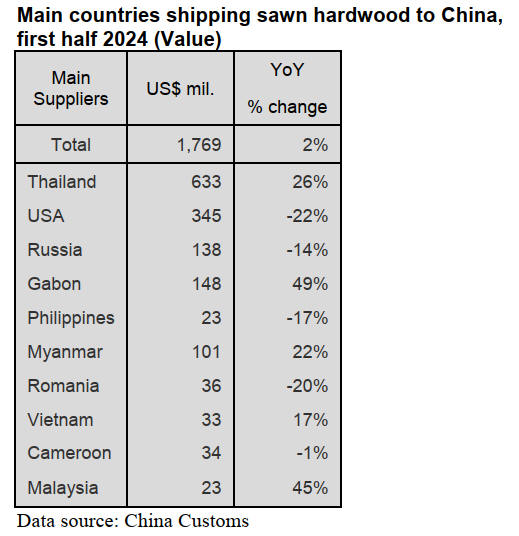
Tropical sawnwood imports rise
China’s tropical sawnwood imports in the first half of
2024 reached 3.69 million cu.m, worth US$1.077 million,
an increase of 16% in volume and 18% in value on the
same period of 2023. They accounted for about 26% of its
national sawnwood import total for the six months. CIF
prices for tropical sawnwood grew 2% to US$292 per
cu.m compared to 2023.
Thailand has been China’s largest tropical sawnwood
supplier for many years. In the first half of 2024 its
shipments to China rose 20% in volume over the same
period in 2023 to 2.49 million cu.m and 25% in value to
US$631 million. They accounted for 68% of China’s total
tropical sawnwood imports, an increase in share of 4%
over 2023. The CIF price for China’s tropical sawnwood
imports from Thailand was US$253 per cu.m, up 4%.
Surge in tropical sawnwood imports from Gabon
Gabon’s tropical sawnwood exports to China rose sharply
in the first half of 2024, making it the country’s second
largest supplier, ahead of the Philippines in third place.
The two countries accounted for for 11% and 8% of
China’s total tropical sawnwood imports respectively in
the period. Imports from Gabon were up 59% to 402,000
cu.m and the Philippines’ 15% to 308,000 cu.m.
China’s top 10 countries tropical sawnwood suppliers
provided 97% of its total first half imports, namely
Thailand (68%), Gabon (11%), Philippines (8%),
Myanmar (4%), Cameroon (1.9%), Malaysia (1.7%),
Indonesia (1.1%), the Republic of Congo (0.8%), Laos
(0.55%) and PNG (0.51%).
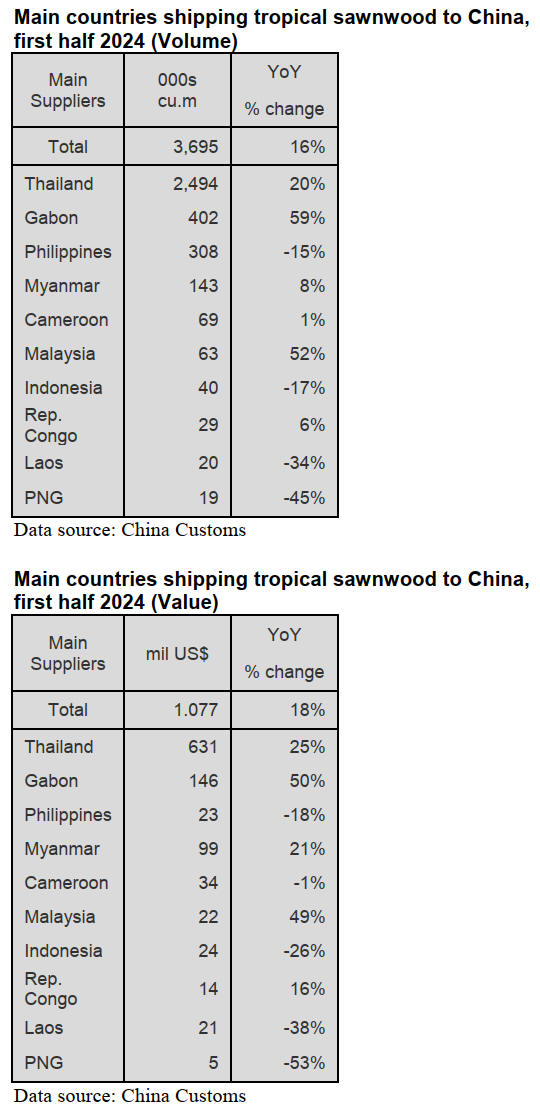
Imported tropical sawnwood CIF prices rise
marginally
Average CIF prices for China’s tropical sawnwood
imports rose 2% to US$292/cu.m in the first half of 2024.
CIF prices for tropical sawnwood from Thailand, the
Philippines and the Republic of Congo grew 4%, 12% and
9% respectively. In contrast, CIF prices for most of
China’s other lead tropical sawnwood suppliers declined at
different rates over the same period in 2023. The price
decrease of imports from PNG was largest, down 16%.

GTI-China Index down in July
In July, the GTI-China Index registered 43.5%, a decrease
of 3.2 percentage points from June, according to the latest
Global Timber Index report. The further drop meant the
index was below the critical value of 50% for three
consecutive months, indicating shrinkage of leading
timber enterprises it represents.
Summer is the traditional off-season for the Chinese
timber market, says the report, but enterprises were
concerned about issues such as blue stain and cracking in
wood, leading to a reduction in production activities.
Typically, the production cycle for the second half of the
year begins in September.
As for the GTI-China Index’s 11 sub-indexes, two
(inventory of finished products, and delivery time) were
above the critical value of 50%. One index (import) was at
the critical value, and the remaining eight were all below.
Compared to the previous month, the indexes in July for
existing orders, inventory of finished products, purchase
quantity, import, inventory of main raw materials, and
delivery time increased by 0.2-3.0 percentage points. The
indexes for production, new orders, export orders,
purchase price, and employees declined by 0.1-8.0
percentage points.
In the first half of 2024, according to the GTI July report,
China's cumulative exports of furniture and furniture parts
reached US$35.379 billion, representing a year-on-year
increase of 14.8%, according to China’s customs statistics.
During the same period, affected by previous high
inventory and still unclear market demand, China's total
import volume of wood was 32.77 million cu.m,
representing a year-on-year decrease of 5.32%.
However, China's demand for tropical sawnwood had
increased significantly. For example, from January to May
2024, China’s import volume of sapelli sawnwood surged
to 45,000 cu.m, a 1.5 times increase compared to the same
period last year.
In terms of freight, with new routes and new shipping
capacity coming on stream, the shipping rates of several
routes departing from China began to show a declining
trend in July.
On July 21, states the GTI report, China, South Africa,
Brazil, and India jointly held the 2024 BASIC Ministerial
Meeting on Climate Change in Hubei Province, China.
The Ministerial Joint Statement on Climate Change
released at the meeting called on developed countries to
end trade distorting subsidies, including those in the
agricultural, forest and energy sectors as they adversely
impact sustainable development in developing countries.
See: https://www.itto-
ggsc.org/static/upload/file/20240822/1724289606498649.pdf
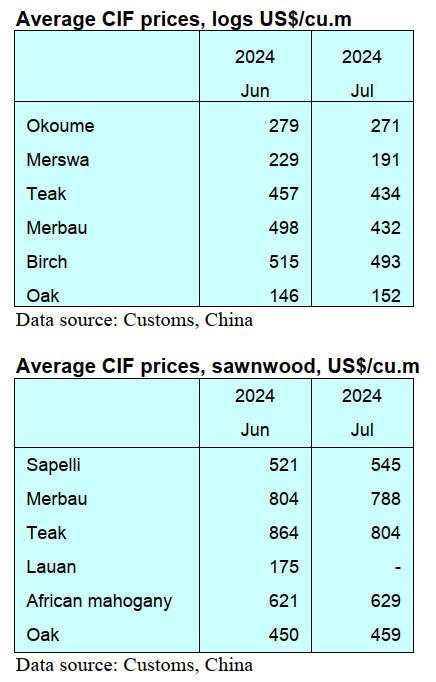

|